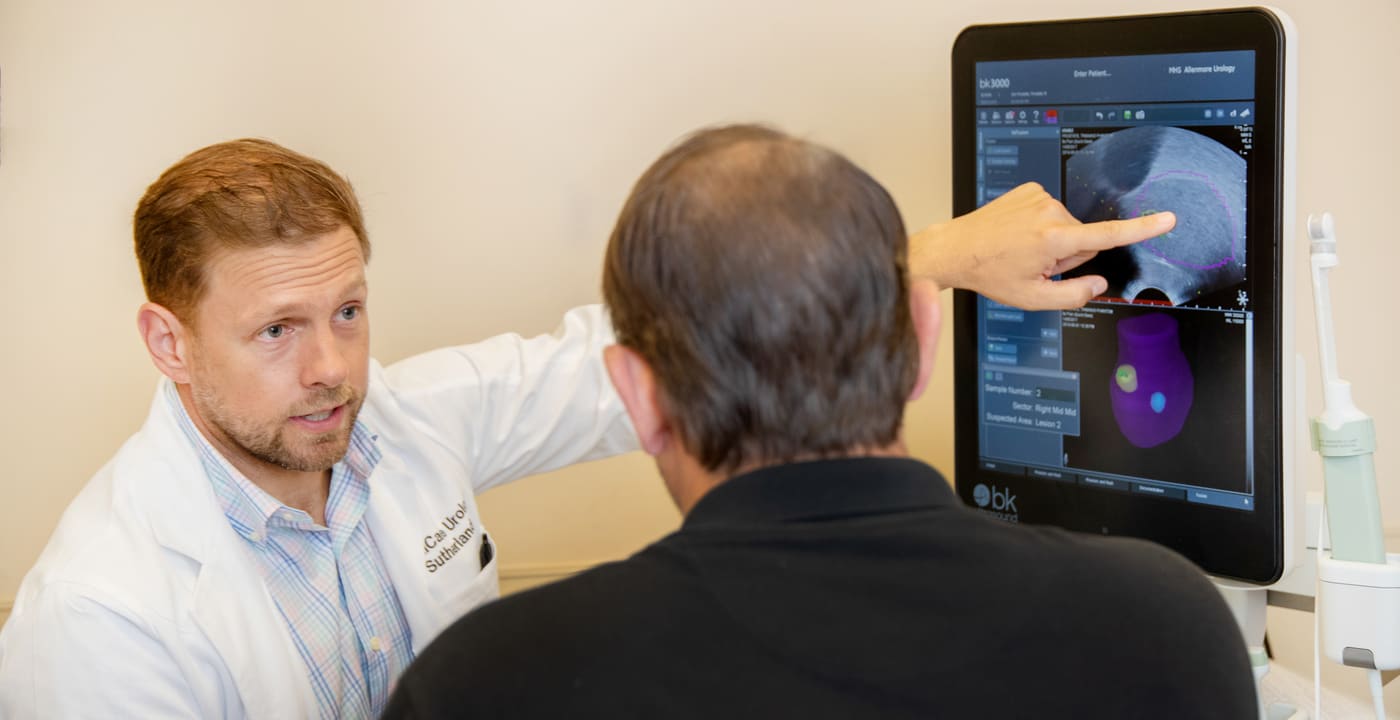What treatments are available for prostate cancer?

Prostate cancer is the second most common cancer in the United States for men after skin cancer.
Prostate cancer survival rates are high when detected and treated early — among the highest of all cancers. However, diagnosis and developing a treatment plan can be complicated because it requires the collaboration of physicians from different specialties.
MultiCare’s urology and oncology teams have partnered to improve the patient experience and offer innovative diagnostic and treatment options for prostate cancer. We dive into the different options below.
Prostate fusion biopsy
For several decades, diagnostic methods didn’t change much and weren’t incredibly accurate until prostate tumors reached a certain size. Often, biopsies missed tumors or probed tissue that wasn’t cancerous, as doctors relied on poor images to guide them.
A state-of-the-art tool called prostate fusion biopsy — covered by most insurance plans — is a radical advancement. First, patients receive an MRI scan. The scan is then combined, or fused, with in-clinic ultrasounds to create a clearer visualization of areas of concern. This helps physicians guide biopsy needles to the precise location.
Not only is this method better at detecting and getting more precise biopsies of tumors that require immediate action, but it also reduces the chances of unnecessarily treating benign tumors. Prostate fusion biopsy gives physicians better information up front, reducing the need for repeat biopsies.
Urologic oncology clinic
For prostate cancer patients who meet certain criteria, MultiCare’s urologic oncology clinic — within MultiCare Cancer Institute at Tacoma General Hospital — creates a one-stop shop for treatment. Urologists, medical oncologists and radiation oncologists collaborate on a patient’s treatment plan before the visit and then coordinate treatments within a single visit.
This collaborative model of care reduces the number of clinic visits required of the patient by bringing various specialists to the patient at a single site. Beyond the convenience to the patient, it’s also an opportunity for even closer collaboration as the physicians work alongside one another.
Innovative treatments for prostate cancer
SpaceOAR hydrogel
SpaceOAR is a minimally invasive injectable gel that creates temporary space between the prostate and the rectum, protecting healthy tissues from exposure during radiation therapy. This treatment reduces side effects such as bowel and urinary incontinence, as well as reducing impacts to sexual function. The gel is gradually absorbed by the body after radiation therapy is completed.
CyberKnife stereotactic body radiation therapy (SBRT) for prostate cancer
Although the name may mislead you — there are no knives or incisions — CyberKnife SBRT is an image-guided treatment that delivers high doses of radiation with extreme accuracy. It targets cancer cells while limiting damage to surrounding healthy tissues and organs. Aside from the reduction in side effects, it reduces the treatment time of conventional radiation therapy (typically eight to nine weeks) to just a few days. Patients can recover faster, with better results.
Xi Robot minimally invasive surgery
MultiCare Tacoma General Hospital has a daVinci Xi Robot, the latest technology available for robotic surgery for urologic cancers. The Xi Robot provides surgeons with better maneuverability and vision, which can help improve outcomes in minimally invasive surgery.
Hormone therapy (androgen suppression therapy)
This therapy is recommended for select patients with advanced stage 4 cancer for whom surgical or radiation therapy alone is not sufficient. The goal is to reduce levels of androgens (a male hormone) to stop them from stimulating the growth of prostate cancer cells. When combined with targeted therapies such as abiraterone or chemotherapy, the results can be even more beneficial.
Radiopharmaceuticals for painful bone metastasis
When cancer spreads to bones, it can sometimes cause great discomfort and impact your quality of life. This therapy involves injecting a group of radioactive drugs such as radium into the body, to settle into bones with cancerous cells and kill them. It can often relieve pain for long periods of time.
Cancer research and clinical trials
Physician researchers at MultiCare are taking part in the fight against prostate cancer. MultiCare offers patients access to clinical trials evaluating new drug treatments and combinations of drug and radiation treatments for men with advanced stage prostate cancer. Clinical research leads to new, breakthrough therapies as well as pairings of approved therapies to improve prostate cancer treatment.
Early detection
The most important thing you can do is become aware of the common early signs and symptoms of prostate cancer, such as:
- Frequent urination
- Weak or interrupted urine flow
- Frequent urge to urinate at night
- Blood in the urine
- Blood in seminal fluid
- New onset of erectile dysfunction
- Pain or burning during urination (much less common)
- Discomfort or pain when sitting caused by an enlarged prostate
Although some of these symptoms can be signs of noncancerous conditions of the prostate, it’s incredibly important to be examined early.
Find a urologist near you to get more information.
Should I be screened for prostate cancer?
Editor’s note: This article was originally published in November 2019 and updated in November 2022.



